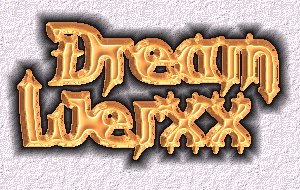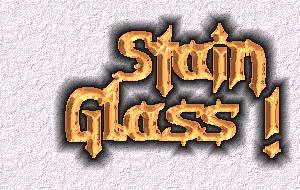  If you have comments or questions, then just
|
|
Index of Stained Glass ImagesNew Hi-Res photos coming sometime in MarchNOTE: Links to samples follow a brief overview of stained glass.NOTE: SubLinks to the following pages are accessable from this location only. See Tips and Hints for Leaded Restorations and/or See How I got interested and/or My restoration experiences or The logic behind these tips. A brief overview of Stained GlassStained Glass provides a medium unlike any other. It cannot be duplicated for beauty by any other medium. Glass has a life of its own, it responds to light and depending on the light source and intensity, the finished product will look different almost every time that you look at it. Plastic repros or painted glass always have the same flat listless quality and are lifeless in comparison.The glass can be purchased in sheet form in virtually any color or shade desired. It can be machine made and always of the same color and pattern like window glass or Cathedral. Cathedral glass is usually lightly textured and of a uniform color. It is the cheapest of the custom glasses used in stained glass work. The more expensive of the glasses includes catspaw, streakies, opalescents, antiques, ripple, gluechip, water glas, etc. The glass sheets may be transparent, transluscent, opaque, or even solid. Or the sheets may be a combination of 2 or more of those effects. These glasses are all considered handmade and each sheet will be different in some way from another of the same type. These glasses are usually multi hued, and frequently have amber or gold overtones that only become apparent in or under certain light conditions. The multi hued glasses are created by pouring 2 or more molten glasses onto the steel sheets and lightly stirring the glasses together. The technique would be similar to a cook making a marble cake. Some of the custom handmade glasses are force cooled by misting, cold water, or ice cubes which cause abstract ridgeing or fractures in the glass. Some glasses are beaten and whipped before allowing to cool. This causes air bubbles to be trapped enhancing the beauty and random patterns. The patterns or ridges are caused by pouring the molten glass onto steel sheets with the desired patterns already in the steel and reversed. These patterns can be geometric such as 'snowflake' or rough bumps as in 'cathedral'. In some cases the glass is further stirred or moved around while the glass is in semi-liquid state. This causes folds in the glass, and since it is no longer liquid, hardens before it has achance to completely flatten out. The colors of glass are caused by certain elements, chemical compounds, or dyes. The cheapest glass is obviously clear. The next cheapest is ambers and greens. The most expensive and hardest to produce is pink glass. This glass sometimes has real gold added to the mix to further enhance the pink color. Top quality handmade pink glass can cost upwards of $30 per square foot. Glass is purchased in varying sized sheets, has a per square foot charge, and the buyers cost is calculated per Square Inch. One of the windows that is included in the samples uses a custom handmade sheet of glass which cost $35 per sq ft. This glass was made by pouring clear glass on a steel table. The glass was stirred while in molten condition to prevent it from being flat and to induce a transluscent rough quality. Pink and green wafer thin glass chips were dropped in random patterns and allowed to fuse with the still semi-liquid clear glass. The wafers are like knives and you very quickly learn NOT to run your hands over the rough backside. Then the glassmaker dripped streams of black glass in thin lines. The overall effect is that the glass looks like an outdoor scene thru badly focused eyes. The black is branches, the green is leaves, and the pink is flowers. The clear glass picks up the normal background (blue sky for example) and adds a further distortion to the view. Since the background will constantly change, the complete window changes its appearance. The sheet of glass (20x40) was a work of art as it stood and it was almost a crime to cut it. The glass is cut to match pattern pieces. It may be ground on the edges for a better fit. The glass pieces are then 'attached' to one another by either lead came (looks like an 'H' turned sideways), or by copper foiling. If foiled, each piece of glass is wrapped around the edge in copper foil and the copper wrapped pieces are ultimately soldered to one another using a high tin content solder. One of the samples windows was a leaded restoration. Lead is the way windows were made for hundreds of years. It is not as strong or as durable as foiling which I believe was first used by Tiffany in his lamps and windows. Leaded windows have much more intrusion on the pattern and the glass pieces are less intricate than with foil. The complete effect is best described as clumsier or clunkier looking than a comparable foiled window. Foiled windows are stronger, allow a greater percentage of the glass to show, and allow for more intricate patterns. The leaded restoration shown was also reproduced in foil and I also modified it slightly for use in my home (the 3rd sample). If you compare the leaded window with the first foiled copy, the difference is quite apparent. The windows or other artistic creations can be further modified by faceted glass gems. These include square, round, or oval. Most of these come from Germany or Austria. The most expensive of the gems are faceted on both sides, just like real gems such as diamonds or sapphires. Because these items are labour intensive, somebody has grind and polish the gems just like a real gem, the cost is very high when projected out. If you wanted to fill a 1 sq. ft. area with nothing but gems, your cost would be in excess of $250 depending on color. Clear is the cheapest, colors, especially red, are more expensive. Beveled glass causes light to refract like a prism throwing small rainbows on the walls, ceiling, floor etc. Because bevels require direct sun for the full effect, Northern exposures are poor location choices. Southern exposure and unshaded or unblocked is the ultimate allowing for interplay all day long. East or West exposure are next best choices and obviously either for interplay in the morning or the afternoon, but not both. The best glass for bevels is 1/4 inch plate (or thicker if possible) with a fairly high lead content. High lead content plate glass usually has a strong green color if viewed on the sides. The glass is safe because 'fairly high' is a relative term. My window used 4 custom bevels which were cut, ground, and polished to my specifications. The 4 pieces which do not exceed 25 sq inches cost me $80. If you are good in math, you will have figured out that this is just about $500 per square foot. Because it is labor intensive, small pieces cost more per square foot than larger pieces. The cost of the glass was marginal, it was all labor. In my mind and as it relates to my window, the final effect was worth the expenditure. Most of the bevels on the market today are only 3/16 or thinner, and do not refract light as well or effectively as 1/4 inch. They do, however, still add a nice touch anyways. These newer bevels come mainly from 3rd world countries where labor is cheap. Consequently the cost is just a fraction of local hand ground items. Stained Glass artwork is generally priced based on the following 4 components.
If you wish to try your hand at Stained Glass, you will need the following. Prices are in approx Cdn dollars from a SG Shop known as Sunrise Glass in London.
I am including a number of samples. Before you look at them, I should tell you that stained glass is very hard if not impossible to photograph. And then I should tell you that my photographic skills leave a lot to be desired. The scanned pics and resulting jpg's have been modified in an attempt to correct the photo's shortcomings, but they are still an extremely poor representation of the real thing with the sun shining through. I am planning on rescanning and modifying now that I have a better scanner and top quality graphic software, but I just don't know when. This watch I am using just doesn't have enough hours on it.  Stained Glass Lamps Stained Glass LampsA few samples of Stained Glass Lamps. The descriptions will indicate the approx size of the article, types of glass used. The lamps are priced and sold without electrical fittings unless otherwise requested. If requested, the units can be prewired using a single socket (not very classy and not preferred) or thru Candlebras. Cost is dependent on choice.
|
HTML by InfoFlex |
 Graphic Enhancements by Flaming Pear |
 All Graphics by JASC |



 Stained Glass Planters
Stained Glass Planters Sun Catchers
Sun Catchers  Windows
Windows  Specialty Items
Specialty Items